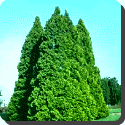 Arborvitae — Thuja is a genus of coniferous trees in the Cupressaceae (cypress family). There are five species in the genus, two native to North America and three native to eastern Asia.
Arborvitae — Thuja is a genus of coniferous trees in the Cupressaceae (cypress family). There are five species in the genus, two native to North America and three native to eastern Asia.
They are commonly known as arborvitae (from Latin for tree of life) or thujas; several species are widely known as cedar but because they are not true cedars (Cedrus) it has been recommended to call them redcedars or whitecedars.
They are evergreen trees growing to 10–60 m tall, with stringy-textured reddish-brown bark. The shoots are flat, with side shoots only in a single plane. The leaves are scale-like 1–10 mm long, except young seedlings in their first year, which have needle-like leaves. The scale leaves are arranged in alternating decussate pairs in four rows along the twigs. The male cones are small, inconspicuous, and are located at the tips of the twigs. The female cones start out similarly inconspicuous, but grow to about 1-2 cm long at maturity when 6–8 months old; they have 6-12 overlapping, thin, leathery scales, each scale bearing 1–2 small seeds with a pair of narrow lateral wings.
The five species in the genus Thuja are small to large evergreen trees with flattened branchlets. The leaves are arranged in flattened fan shaped groupings with resin-glands, and oppositely grouped in 4 ranks. The mature leaves are different from younger leaves, with those on larger branchlets having sharp, erect, free apices. The leaves on flattened lateral branchlets are crowded into appressed groups and scale-like and the lateral pairs are keeled. The solitary flowers are produced terminally. Pollen cones with 2-6 pairs of 2-4 pollen sacked sporophylls. Seed cones ellipsoid, typically 9-14mm long, they mature and open the first year. The thin woody cone scales number from 4-6 pairs and are persistent and overlapping, with an oblong shape, they are also basifixed. The central 2-3 pairs of cone scales are fertile. The seed cones produce 1 to 3 seeds per scale, the seeds are lenticular in shape and equally 2 winged. Seedlings produce 2 cotyledons.
They are widely grown as ornamental trees, and extensively used for hedges. A number of cultivars are grown and used in landscapes. The cultivar ‘Green Giant’ is popular as a very vigorous hedging plant, growing up to 80 cm/year when young.
The wood is light, soft and aromatic. It can be easily split and resists decay. The wood has been used for many applications from making chests that repel moths to shingles. Thuja poles are also often used to make fence posts and rails. The wood of Thuja plicata is commonly used for guitar soundboards.
 Kids Portal For Parents India Kids Network
Kids Portal For Parents India Kids Network






